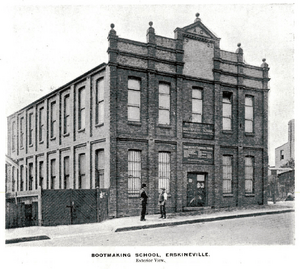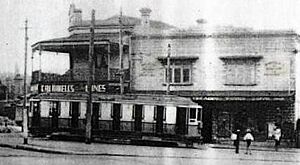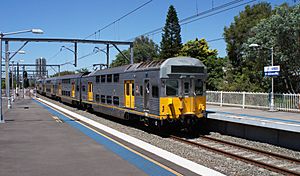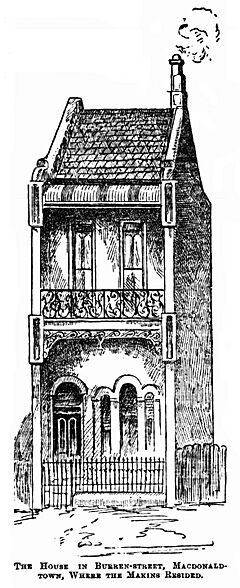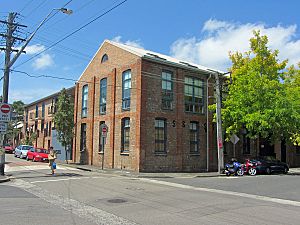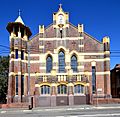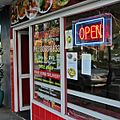Erskineville facts for kids
Quick facts for kids ErskinevilleSydney, New South Wales |
|||||||||||||||
|---|---|---|---|---|---|---|---|---|---|---|---|---|---|---|---|
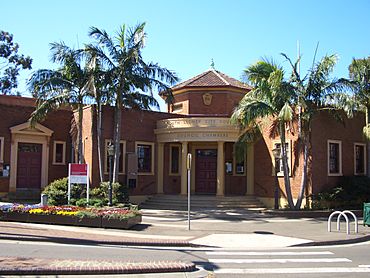
Erskineville Town Hall
|
|||||||||||||||
| • Density | 5,246.4/km2 (13,588/sq mi) | ||||||||||||||
| Postcode(s) | 2043 | ||||||||||||||
| Area | 1.6 km2 (0.6 sq mi) | ||||||||||||||
| Location | 6 km (4 mi) south west of Sydney CBD | ||||||||||||||
| LGA(s) | City of Sydney | ||||||||||||||
| State electorate(s) |
|
||||||||||||||
| Federal Division(s) | Sydney | ||||||||||||||
|
|||||||||||||||
Erskineville (once called Macdonaldtown) is a suburb in the Inner West part of Sydney, New South Wales, Australia. It is about 6 kilometres south-west of the main city centre. Erskineville is part of the City of Sydney local government area. It's a diverse place with people from many different backgrounds, including those from Southeast Europe and Aboriginal communities. People often call it Erko for short.
Erskineville is surrounded by other suburbs. To the west is Newtown, to the north is Redfern, to the south is St Peters, and to the east is Alexandria. A small area called Macdonaldtown is just over its north-west border. Erskineville is mostly a place where people live. You can find Erskineville Oval, a sports ground, on the eastern side of the suburb.
Contents
Welcome to Erskineville!
A Look at Erskineville's Past
The area was first known as Macdonaldtown. This name came from a piece of land owned by Stephen Macdonald in 1846. In the early 1800s, Macdonaldtown and Erskineville were used for homes and farms.
How Erskineville Got Its Name
The name Erskineville comes from Erskine Villa, a house built in 1830. It belonged to Reverend George Erskine, a Wesleyan minister. The house later became a church rectory before being taken down in 1961.
Some streets in the area are named after early residents. Devine Street is named after Nicholas Devine, who owned a farm called Burren Farm. Burren Street is also named after his farm. Other streets like Amy, Flora, and Eve are named after the Macdonald family. Knight Street is named after Henry Knight, an early brickmaker and the first mayor of Macdonaldtown.
Growing Up: From Farms to Factories
The area became an official town on May 23, 1872, as the "Municipal District of Macdonald Town." In 1893, its name was changed to Erskineville.
At first, many people in Erskineville were market gardeners, growing food to sell. Later, making bricks and tanning leather became important jobs. The small houses and terraces you see today were built for the workers in these industries.
In the 1900s, more factories opened, and Erskineville became a busy working-class suburb. In 1938, new public housing was built to help people find homes. From the 1970s, more people started moving to Erskineville. They liked its friendly feel, easy access to public transport, and how close it was to the city.
For a long time, the south-eastern part of Erskineville was full of large factories. Companies like Bakewell Brothers made bricks, and Metters Limited made stoves. Steel factories also operated here. Many of these industrial areas are now being redeveloped into new homes and apartments.
Getting Around Erskineville
Trams: A Blast from the Past
Long ago, Erskineville had electric trams! One tram line opened in 1909. It ran from Circular Quay in the city, through different streets, and ended in Erskineville. Part of this line closed in 1940, and the rest stopped running in 1958.
Another short tram line, the Henderson Road line, opened in 1906 and closed in 1933. These trams were a popular way to travel before cars became common.
Trains and Buses Today
Today, trains are a main way to get around. The railway line was extended to Erskineville between 1884 and 1893. Erskineville is served by the Bankstown Line of the Sydney Trains network. Nearby stations like Newtown, Macdonaldtown railway station, and St Peters railway station are also close by.
Buses also run through Erskineville. You can catch a bus from Marrickville Metro shopping centre all the way to Bondi Junction.
Erskineville in Movies and Music
Erskineville has been featured in popular culture!
- The Imperial Hotel is a famous pub known for its drag shows. It was featured in the movie Priscilla, Queen of the Desert.
- The indie film Erskineville Kings was set in Erskineville. This was one of the last movies Hugh Jackman worked on before he became famous as Wolverine in X-Men.
- The famous hard rock band Wolfmother grew up and formed here.
- An online puzzle called Cicada 3301 had a clue (a poster) found in this suburb.
Who Lives in Erskineville?
| Historical population | ||
|---|---|---|
| Year | Pop. | ±% |
| 2001 | 4,818 | — |
| 2006 | 6,558 | +36.1% |
| 2011 | 6,848 | +4.4% |
| 2016 | 8,014 | +17.0% |
| 2021 | 9,657 | +20.5% |
In 2021, the population of Erskineville was 9,657 people.
In 2016, there were 8,014 residents. Many people had English (24.6%), Australian (17.0%), or Irish (10.9%) backgrounds. About 59.1% of people were born in Australia. Other common birthplaces included England (7.2%) and New Zealand (3.2%). Most people (74.6%) spoke only English at home.
When it came to getting to work, many people (45.9%) used public transport, while 28.1% drove a car. Most homes in Erskineville are flats or units (55.3%) or semi-detached houses (40.2%). About half of the residents (50.1%) were renting their homes.
Famous People from Erskineville
Many interesting people have lived in Erskineville, including:
- Stuart Challender, a conductor who led the Sydney Symphony Orchestra.
- Members of the band Wolfmother: Myles Heskett, Chris Ross, and Andrew Stockdale.
- John Prior, a musician and composer.
- Jon Cleary, a novelist.
- Felix Dean, an actor from the TV show Home and Away.
- Natalie Imbruglia, a singer and actress.
- Daniel Johns, a musician from the bands Silverchair and The Dissociatives.
- John Kennedy, a singer-songwriter.
- Paul Mac, a musician and DJ.
- Jackie Orszaczky, a musician and composer.
- Urthboy, an Australian hip hop artist.
- David White, an Academy Award-winning sound designer.
Learning in Erskineville
Erskineville has two primary schools (for kids from Kindergarten to Year 6):
- Erskineville Public School, which opened in 1883.
- St Mary's Catholic Primary School, which opened in 1887.
For high school, students in Erskineville can go to Newtown High School of the Performing Arts. Other nearby high schools include Alexandria Park Community School, Marrickville High School, and Tempe High School.
Protecting Erskineville's History
Erskineville has many special places that are protected because of their history. About 75% of the suburb is covered by "Heritage Conservation Areas." This means that buildings and areas within these zones have special rules to help keep their historical look and feel.
Special Heritage Areas
Some of these areas include:
- Burren Estate Heritage Conservation Area, which includes the Town Hall.
- Toogood and White's Estate Heritage Conservation Area.
- Former Macdonaldtown Heritage Conservation Area.
- Pleasant Avenue Heritage Conservation Area.
- Parts of the King Street Heritage Conservation Area, shared with Newtown.
- Erskineville Estate Heritage Conservation Area, which includes Macdonaldtown Park.
- Malcolm Estate Heritage Conservation Area, near the Public School.
- Parts of the Kingsclear Road Heritage Conservation Area, shared with Alexandria.
Important Buildings and Places
Many individual buildings in Erskineville are also listed as heritage items, meaning they are important to the area's history. These include:
- The former Cosmopolitan Hotel (built between 1880 and 1910).
- The former Bakewell Brothers warehouse (built 1914–1919).
- The Imperial Hotel (around 1940), known for its unique design.
- The Holy Trinity Anglican Church Group (from 1885).
- The Erskineville Hotel (1940), an Art Deco style pub.
- The Erskineville Town Hall (1938), which used to be the local government building.
- The front of the former St Peter's Theatre (1927).
- A former factory chimney stack (1916), important for its connection to old Australian manufacturing.
- The former Macdonaldtown Post Office (around 1873).
- Erskineville Public School (from 1883).
- The Rose of Australia Hotel (1934).
- St Mary's Catholic Church Group (1912).
- The former Cleveland Shoe Company factory (1923).
Images for kids


